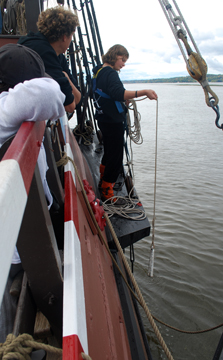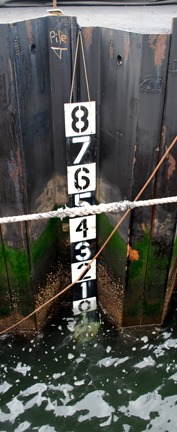 |
|
|
|
 |
When traveling through uncharted waters, one of the most basic questions a ship's crew needs to be able to answer is also one of the most important: How deep is the water? In fact, as Juet's journal entries show, Captain Hudson and his crew repeatedly faced the danger of running aground while exploring the river that would bear his name.
Monitoring water depth is just as important for us on board the Replica Ship Half Moon. Of course, in 21st century the Hudson River has been throughly charted and (unlike Captain Hudson) we have experience navigating this river, but that doesn't mean there are no uncharted waters for us to explore. On Day Two, we chose to travel down the narrow, secondary channels between Cementon and Kingston.
When in doubt, we take soundings (measure the water's depth) with the same tool Hudson's crew would have used: a lead line (or sounding line). Flags attached to the lead line mark depth in 6-foot increments (fathoms). The Half Moon has a draft of 8-1/2 feet (extending that far underwater), so it needs at least a fathom and a half of water to stay clear of the bottom.

In Hudson's day, crews would even use their lead lines to take samples of the river bottom. They could fill a small hollow on the bottom of the line's lead weight with tallow or grease, then see what stuck to this goo when they retrieved the line. Silt or sand made for a fine anchorage, but clean tallow warned of rocks lurking below, making anchorage dangerous if not impossible.
On this voyage, the research team of Matt and Jason measured the depth of tide for their presentation project. During our data collection layover at the Kill Van Kull, we borrowed a depth marker from Atlantic Salt and hung it from the dock. Using this simple device rather than the lead line allowed Matt and Jason to collect their data quickly, accurately, and safely, without having to gear up and climb out onto the channel for each reading. This was particularly important during Anchor Watch, since they would be collecting data through the night.
